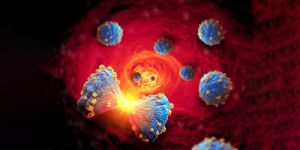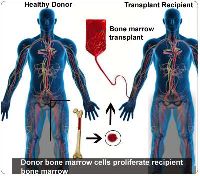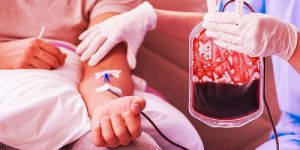
Multiple Myeloma Treatment
Myeloma is a form of blood cancer of the plasma cells in the bone marrow. This condition occurs when plasma cells become cancerous and produce tumours called plasmacytomas. This is also called multiple myeloma because a person may have more than one plasmacytomas. Plasma cells are the white blood cells formed in the bone marrow that create large amount of antibodies. Bone marrow is the spongy tissue found inside some of the bones and is where all blood cells are formed. Multiple Myeloma Treatment in Delhi is now available at Dr Gaurav Dixit’s clinic.
...more
Lymphoma Treatment in Delhi
Lymphoma is one of the most common types of blood cancer which begins in cells of the lymph system. Lymphoma affects lymphocytes. Lymphocytes are a type of white blood cells which travel through the blood and lymphatic system to defend the body against foreign substances such as bacteria and viruses. In lymphoma, the growth of lymphocytes is out of control, they replicate faster than normal lymphocytes and live longer as they travel in the whole body through the blood and lymphatic system so lymphoma can spread in many parts of the body including spleen, bone marrow, lymph nodes, and other organs. Two main types of lymphoma are: Hodgkin lymphoma (HL): There are five types of Hodgkin Lymphoma. Non-Hodgkin lymphoma (NHL): There are over 90 types of NHL. Lymphoma is very much curable, but the outlook depends on the stage of lymphoma and its type.
...more
Leukemia Treatment in Delhi
What are the first signs of leukemia? Leukemia is cancer in the blood-forming tissues of the body. It can even be found in the bone marrow or the lymphatic system. It often involves white blood cells. In the bone marrow, it produces abnormal white blood cells which do not function properly and can be dangerous to the body. Leukemia does not produce any apparent symptoms at an early stage. Sometimes these symptoms are those of common illness. One of the symptoms is anemia. Anemia occurs when there is a shortage of red blood cells in the body. What usually is a sign of leukemia, especially if you have pale skin or headaches because of it. Patients with leukemia also tend to be prone to get infections very fast, and this is mostly because of the high level of white blood cells present in the body. Other symptoms include bone or joint pain. Even your body swells because various parts of your body are affected by it. Another sign of leukemia is a sudden loss of appetite, which causes damage. There is also a tendency to bruise or bleed easily, including bleeding from the gums or nose, or blood in the stool or urine.
...more
Bone Marrow Transplant In Delhi
Bone marrow transplantation is a procedure wherein stem cells from bone marrow that produce various blood cells like red blood cells, white blood cells and platelets are injected into a recipient after a short course of chemotherapy called conditioning. These stem cells are also referred to as hematopoietic stem cells. Nowadays, hematopoietic stem cells may also be obtained from peripheral blood after treatment with certain growth factors or from umbilical cord. Thus , the term "Hematopoietic stem cell transplantation" is now preferred to "Bone marrow transplantation" to include these other sources of hematopoietic stem cells.
...more
Anaemia Treatment In Delhi
Out of all the blood-related disorders, anaemia is the most common and prevalent one, affecting more than half of the world population. As per a Global Nutrition report, India was placed at the bottom of the list with the maximum number of anaemic women in the world. More than about 51% of women in India belonging to the reproductive age are suffering from anaemia. So, the big question is what anaemia really is and how it affects people’s health. Anaemia refers to a condition where a person lacks enough red blood cells in his blood to carry adequate oxygen to various body tissues. When a person suffers from anaemia it can make him or she feel tired to perform even his everyday activities. Let us have a look at what causes anaemia and the Best Anaemia Treatment in Delhi.
...more
Leukemia Treatment Service

Lymphoma Treatment

Bone Marrow Transplant

chemotherapy services
Chemotherapy is the administration of drugs that kill rapidly dividing cells such as leukemia or other cancer cells. Chemotherapy may be taken orally in pill or tablet form, or it may be delivered via a catheter or intravenous line directly into the bloodstream. Combination chemotherapy is usually given, which involves a combination of more than one drug. The drugs are given in cycles with rest periods in between. Sometimes, chemotherapy drugs for leukemia are delivered directly to the cerebrospinal fluid (known as intrathecal chemotherapy). Intrathecal chemotherapy is given in addition to other types of chemotherapy and can be used to treat leukemia in the brain or spinal cord or, in some cases, to prevent spread of leukemia to the brain and spinal cord. Side effects of chemotherapy depend on the particular drugs taken and the dosage or regimen. Some side effects from chemotherapy drugs include hair loss nausea, vomiting, mouth sores, loss of appetite, tiredness, easy bruising or bleeding, and an increased chance of infection due to the destruction of white blood cells. There are medications available to help manage the side effects of chemotherapy. Some adult men and women who receive chemotherapy sustain damage to the ovaries or testes, resulting in infertility. Most children who receive chemotherapy for leukemia will have normal fertility as adults, but depending on the drugs and dosages used, some may have infertility as adults.
...more
Biological Therapy Services
Biological therapy is any treatment that uses living organisms, substances that come from living organisms, or synthetic versions of these substances to treat cancer. Biological therapies for various types of cancer can include antibodies, tumor vaccines, or cytokines (substances that are produced within the body to control the immune system). Monoclonal antibodies are antibodies that react against a specific target that are used in the treatment of many kinds of cancer. Interferons are cell signaling chemicals that have been used in the treatment of leukemia. Side effects of biological therapies tend to be less severe than those of chemotherapy and can include rash or swelling at the injection site for IV infusions of the therapeutic agents. Other side effects can include headache, muscle aches, fever, or tiredness.
...more
Targeted Therapy Services
Targeted therapies are drugs that interfere with one specific property or function of a cancer cell, rather than acting to kill all rapidly growing cells indiscriminately. This means there is less damage to normal cells with targeted therapy than with chemotherapy. Targeted therapies may cause the target cell to cease growing rather than to die, and they interfere with specific molecules that promote growth or spread of cancers. Targeted therapies are given in pill form or by injection. Side effects can include swelling, bloating, and sudden weight gain. Other side effects can include nausea, vomiting, diarrhea, muscle cramps, or rash.
...more
radiation therapy services
Radiation therapy uses high energy radiation to target cancer cells. Radiation therapy may be used in the treatment of leukemia that has spread to the brain, or it may be used to target the spleen or other areas where leukemia cells have accumulated. Radiation therapy also causes side effects, but they are not likely to be permanent. Side effects depend on the location of the body that is irradiated. With any radiation therapy, the skin in the area being treated may become red, dry, and tender. Generalized tiredness is also common while undergoing radiation therapy.
...more
Stem Cell Transplant Treatment
In stem cell transplantation, high doses of chemotherapy and/or radiation are given to destroy leukemia cells along with normal bone marrow. Then, transplant stem cells are delivered by an intravenous infusion. The stem cells travel to the bone marrow and begin producing new blood cells. Stem cells may come from the patient or from a donor. Autologous stem cell transplantation refers to the situation in which the patient's own stem cells are removed and treated to destroy leukemia cells. They are then returned to the body after the bone marrow and leukemia cells have been destroyed. An allogeneic stem cells transplant refers to stem cells transplanted from a donor. These may be from a relative or an unrelated donor. A syngeneic stem cell transplant uses stem cells taken from a healthy identical twin of the patient. Stem cells may be removed (harvested) in different ways. Typically, they are taken from the blood. They can also be harvested from the bone marrow or from umbilical cord blood. Stem cell transplantation is done in a hospital, and it is necessary to remain in the hospital for several weeks. Risks of the procedure include infections and bleeding due to the depletion of normal blood cells. A risk of stem cell transplant with donor cells is known as graft-versus-host disease (GVHD). In GVHD, the donor white blood cells react against the patient's normal tissues. GVHD can be mild or very severe, and often affects the liver, skin, or digestive tract. GVHD can occur at any time after the transplant, even years later. Steroids or medications that suppress the immune response may be used to treat this complication.
...moreBe first to Rate
Rate ThisOpening Hours